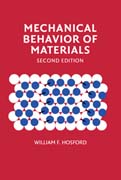
This textbook fits courses on mechanical behavior of materials in mechanical engineering and materials science and includes numerous examples and problems.It emphasizes quantitative problem solving. This text differs from others because the treatment of plasticity emphasizes the interrelationship of the flow,effective strain, and effective stress and their use in conjunction with yield criteria to solve problems. The treatment of defects is new, as is the analysis of particulate composites. Schmid's law is generalized for complex stress states. Its use with strains allows for prediction of R-values for textures. Of note is the treatment of lattice rotations related to deformation textures. The chapter on fracture mechanics includes coverage of Gurney's approach. Among the highlights in this new edition are the treatment of the effects of texture on properties and microstructure in Chapter 7, a new chapter (12) on discontinuous and inhomogeneous deformation, and the treatment of foams in Chapter 21. INDICE: 1. Stress and strain; 2. Elasticity; 3. Mechanical tensile testing; 4. Strain hardening of metals; 5. Plasticity; 6. Strain-rate and temperaturedependence of flow stress; 7. Slip; 8. Dislocation geometry and energy; 9. Dislocation mechanics; 10. Mechanical twinning; 11. Hardening mechanisms; 12. Discontinuous and inhomogeneous deformation; 13. Ductility and fracture; 14. Fracture mechanics; 15. Viscoelasticity; 16. Creep and stress rupture; 17. Fatigue; 18. Residual stresses; 19. Ceramics; 20. Polymers; 21. Composites; 22. Mechanical working; Appendix I. Miller indices; Appendix II. Stereographic projection.
- ISBN: 978-0-521-19569-0
- Editorial: Cambridge University
- Encuadernacion: Cartoné
- Páginas: 436
- Fecha Publicación: 07/01/2010
- Nº Volúmenes: 1
- Idioma: Inglés
